Von Collins is an accomplished triathlete and endurance cyclist, and the author of four fitness and training books: Smarter Running, Your First Triathlon Guide, Fit Foods, and 30 Rut-Busting Workouts. He has been cited as a triathlon, cycling, and fitness expert by Healthline, CNET, Forbes, Eat This, Not That and other major outlets.
The Flux models, the Flux 2 and Flux S by Tacx, are solid smart trainer options for the money. The term “sweet spot” comes to mind when writing about them — they occupy a nice price point but also provide impressive functionality.
What we like most about the Flux models is that they give you a full ability to enjoy smart bike training, but hold off on just enough of the “splurge” features to provide a significant value.
Tacx is a legitimate leader in the connected smart trainer market. Best known for the “hold nothing back” Neo 2T, a high-end trainer, Tacx has a couple more affordable smart trainers on the market too. The Flux lineup makes the outstanding Tacx technology a little more accessible who want to keep their investment under $1,000.
Here, we will take a hard look at the two Flux models — the Flux 2 and the Flux S. You can get them both direct from Garmin, here.
Tacx Smart Trainer History and Lineup
Tacx has been making smart trainers since 2014, but the company has been around a lot longer than that. Tacx is one of the longstanding cycling companies, originally building old-fashioned rollers and roller parts. Rollers gave way to spinners and trainers, which gave way to the smart bike trainers we know today. Actually many rollers and traditional trainers are still in use by people across the globe.
While the Neo 2T sits atop the lineup for Tacx, the Flux models — the 2 and the S, are lower-priced options that can be great buys for some riders, depending on what you are looking for.
Today, Tacx is owned by Garmin, the maker of everything from GPS units to the best fitness watches on the market. If you are into other Garmin equipment, it might be to your advantage to go with a Tacx trainer. Garmin tends to add features that are only available to people on their platform with every new product release.
Tacx Flux Competition and Alternatives
The Flux 2 and Flux S sit in a unique spot in the market. The primary competition probably comes from the Wahoo KICKR Core, the less-expensive version of the Wahoo KICKR. Saris, another heavy-hitter in the industry, only makes the one trainer — the Saris H3 — but they keep some bells and whistles off and price it just a hair above the two flux models.
I guess you could say the other competition for the Flux 2 and Flux S are traditional bike trainers, which sell for less. But comparing traditional vs. smart trainers is really like comparing apples and oranges, which is why we really don’t consider them competition.
We commend Tacx for offering these lower-priced options to the decked-out Neo 2T, much like we like the fact that Wahoo has a KICKR Core option for people looking to save a few bucks. What do you lose out on by spending less on the Flux models versus the Neo lineup? We go in to more detail down below, but in short you will get a lighter flywheel and less of a ride-simulating feel.
Don’t let that make you think you won’t get great workouts on a Flux. You can get the same sweat on a Flux that you will on a Neo or Peloton, only or much less.
Flux Ride Experience
We love riding Tacx products, because are smooth to pedal, very quiet, and connect seamlessly with your app — no matter which you are using.
For the money, we found that both the Flux 2 and Flux S provide a great indoor riding experience. Fully connected, you really don’t lose any compatibility with the bike training app that you use, be it Zwift, Sufferfest, Rouvy, Trainerroad, or something else.
Our experience with the ride quality was excellent — the Tacx Flux is smooth, although you will notice that you don’t quite have the resistance that you do with the Neo 2T. That is because the flywheel is smaller.
This is a good time to note some of the differences between the Flux 2 and Flux S, and it starts with the aforementioned flywheel. Think about the Flux 2 as being midway in between the low-end Flux S, and the high-end Neo 2T. The flywheel on the Flux S is the smallest, while the Neo 2T has a big, heavy flywheel. The Flux 2 is positioned right in the middle, in a sweet spot of sorts.
Why is this important? Because the flywheel size is a big factor in your ride experience, especially at heavier resistance levels. Flywheel size and weight determines several things: The overall resistance you can get (max wattage), the responsiveness of increases and decreases in power, and in some cases the smoothness of the overall ride — although Tacx tends to excel on that last point, regardless of which model we are talking about.
We found that the flywheel of a Flux model is going to be enough to give us some really hard work, and we think it will work for most riders as well. We found that the Flux can give a solid, stable resistance in that magic zone of 150 to 400 watts, which is where most riders will spend their time. Spurts up to 900 watts were high-quality. The Flux 2 is going to be a bit more smooth and stable if you are someone who does intervals (or climbs on Zwift) and really wants to push into high wattage routinely.
The Flux 2 offers a max power of 2,000, the Flux S offers 1,500. Both are enough for virtually any rider out there, although if you are a semi-pro, it is nice to not be riding at the very top-end of the trainer’s limits.
With all of that said, there is a difference in the inertia you feel when riding the Flux 2 vs. Flux S, so if you are asking yourself “what makes the 2 worth $150 more?”…. that is probably the main factor. When riding in ERG mode — the mode where the trainer automatically raises and lowers your resistance based on the prescribed wattage level for a certain interval or segment — you will feel more latency in the S than you will in the 2, when changing power levels.
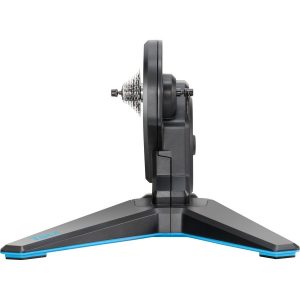
Our assessment is that Tacx does probably the best job in the industry of making its products with a real road-feel. You get all the bells and whistles on the Neo 2T, which will spoil you, but many of the features spill over into both of the Flux models. The Flux 2 simulates inclines of up to 16% (no descent simulation) and the larger flywheel — than the Flux S — will give you resistance that feels a bit more like the road. The Flux S, by the way, can simulate an incline of up to 10%.
The footprint of both Flux models is identical. You will need a little more than 2 feet of side-to-side space to fit the Flux trainer along with its feet, plus enough length for your bike obviously.
Speaking of the feet, you assemble them when you receive the unit, and they are highly-stable. While the Neo 2T might feel just a little more solid when you are really ripping up the frame, you should not have any stability issues if you go with the Flux options.
The Flux 2 weighs about 2 pounds more, at 52 lbs. This weight gives both Flux models an advantage, in our opinion, over the comparably-priced Wahoo KICK Core, which is 10 lbs lighter. You may notice that when cranking really hard, as the Flux models both tend to stay in position better and with more stability. They will have even more traction with floor if you opt for the Tacx bike trainer mat underneath, a nice, rollable mat that is easy to stow away.
None of the Tacx models fold very well, which is one of the few knocks against an otherwise excellent design.
Tacx Flux 2 vs. Tacx Flux S
As noted earlier, the Tacx Flux 2 and the Tacx Flux S are two different models, with about a $150 price difference. Both are very good.
The Flux 2 is the superior trainer. It gives you the ability to simulate inclines, and about 15% stronger flywheel. How does this make a difference? When a strong cyclist is accelerating, or simulating an uphill, the heavier flywheel will better simulate a real-life situation. A larger flywheel just feels more like being on the road with actual gravity and resistance.
Plus, if you are one of those people who can really crank out major power, you might want the ability to produce higher power.
We found the Flux 2 to be slightly quieter as well, but when you are looking at Tacx, everything they offer is quiet.
If you can spend the extra $150, do it. But we recommend both Flux models.
Connectivity and Compatibility
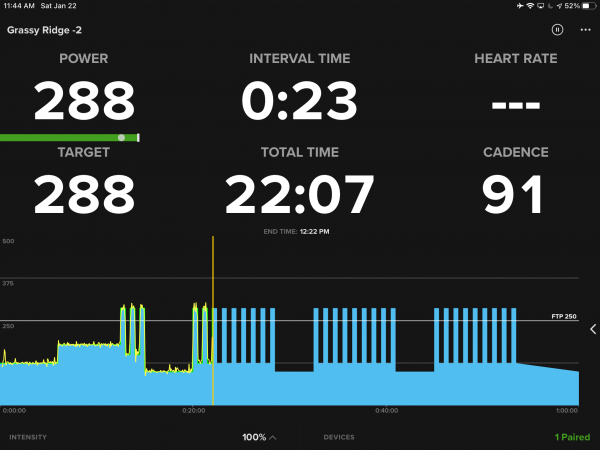
You won’t have any issues connect either of the Flux models to your favorite app, whether you ride the gamification of Zwift and Rouvy or the structured workouts of Sufferfest or Trainerroad. Connecting is nearly instantaneous. Just begin pedaling, and as long as your app is activated, the trainer and app should find each other in seconds.
As we cranked up the Flux to our Zwift and Trainerroad setup, it rarely took more than 7 seconds to connect, and we never had an issue where the app did not find the trainer.
As noted before, non of the Tacx models come with a cassette on them, you will need to supply and install it yourself. After much testing and experience, we suggesting buying a cassette that is very similar to the one you normally ride. It is important to have the same number of teeth (10 and 11-tooth cassettes are both very common) so your shifting is consistent and you can get a simulated ride experience. Can you simply use the cassette from your bike? Sure, but we find swapping out cassettes to be a pain, and if have the budget, just buy a second one to keep mounted on the trainer.
Noise
It is no secret that we love the noise level of the Tacx smart trainers. While the competition is catching up in this regard, Tacx has always been a leader in making extremely quiet trainers. Expect either of the Flux models to clock in at about 63 decibels, while their father, the Neo 2T, comes in close to 60 or even the high 50s. The comparable models from other brands are now hovering in the 60 range as well.
Noise is not as much of a differentiator as it used to be! All good brands seem to be prioritizing lower noise levels and catching up.
Accuracy
There has been some buzz about the Flux models not delivering the ideal accuracy for a smart trainer, but we have not experienced any issues ourselves.
The belief — which seems to be shared by Tacx — is that *some Flux units tend to be a little off (low) when measuring power output at lower flywheel speed (not lower cadence — but lower flywheel speed which is usually your higher wattage output). It doesn’t happen with every unit. Given Tacx’ 1-year warranty, you should have more than enough time to determine if you are not happy with the power accuracy of your particular unit. If, by chance, you get one of the small fraction that might not be within the expected 2.5% – 3% margin of error, return it for a replacement.
How do you know? Ride the smart trainer with a separate power meter also on your bike, and then compare output. Be sure to compare at different cadences, in different chainrings, and various power levels. If they are off by more than about 3%, one of them is wrong. If they are within 1-3%, you are probably just fine. If you are within less than 1%, you are locked-in.
Because of the different flywheel weights in the Flux 2 and Flux S — again, the Flux 2 is larger and heavier — you are going to find that the 2 is more responsive when you are quickly increasing your power. The S will have just a bit of latency. We said it earlier, but that flywheel weight is really the main thing you get by spending $150 more on the 2. And by upgrading to the Neo 2T, you would get an even heavier one.
Mounting and Drive
Like the Neo 2T, the Flux models are both direct-drive trainers, meaning that you remove your back wheel, drop the bike frame on to the trainer axle, tighten the skewer, and ride.
Tacx trainers do not come with cassettes pre-installed (Wahoo is the only brand that does) so you will need to put a cassette on. This is something that experienced cyclists have probably done before, but for a novice it can be a new task. It is pretty simple, and besides a cassette the only thing you need is a cassette wrench.
Tacx trainers are most compatible with Shimano cassettes (we like the 11 speed version). If you use another brand such as a SRAM, you will need to install the adapter. We find it is easiest just to invest in a Shimano 11 cassette when you purchase the trainer, and leave it on forever — or swap it out to your new trainer if you ever decide to get a new one.
Safety
Safety is an important feature in all smart trainers. What good does it do to go in to every last detail about the technical specs of a trainer, if it is not safe to ride? Fortunately, Tacx does a great job in this regard, overall.
The base of the Flux 2 and Flux S models are identical. The footprint provides a stable base so you are not going to be at risk of wobbling in the saddle, and you can even get up out of the saddle and sprint without much unwanted side-to-side motion. At about 50 pounds, both Flux models are also heavy enough to not pull them up off the ground when doing a hard spin — something that can happen on light models if the rider is going really hard.
The design of the Flux models does not create any kind of abnormal liability in terms of moving parts or dangerous appendages. Overall, it is a compact unit, the flywheel generally concealed in a shroud. Of course, it is a moving bike drivetrain, so if you have a toddler nearby you will want to teach them to keep some distance — but that is the case with any trainer.
Riders on both Flux models can weigh up to 275 lbs, the same as the Neo. That is in the range of what we see for most smart trainers — ranging from 250 lbs (Wahoo) to 300 lbs (Saris and Peloton). For most riders, the Flux will work just fine.
Durability
Tacx makes a really good smart trainer that should not require lots of support once you purchase it. We really don’t hear of many people who need to mess with either the firmware or the trainer itself — something that we can’t necessarily say for other competing brands.

Buying a smart trainer is not a trivial expense, and we know that any downtime can really affect the value that you get from it. Based on what we can see, and our first-hand riding experience so far, we don’t see any issues that you would likely experience with a Flux, outside of the random power calibration issue mentioned above, which affects just a small fraction of models, and should be covered by warranty.
Tacx Flux Price Point
Here is where Tacx makes things interesting. Very competitive price points, overall, and two sub-$1,000 trainers, while most makers have just one.
The Flux 2 has a price point of $900, right at the spot where it competes head-on with Wahoo’s KICKR Core, and just a tick below the Saris H3 — Saris’ top-of-the-line trainer. $900 puts it in a position where it is not trying to compete with the “all-decked-out” trainers, but it is a step-up from the entry-level smart trainers.
The Flux S has a price point of $750, putting it near the entry-level of all smart-trainer pricing. Even considering the smaller flywheel and slight latency in responsiveness in certain situations, we are impressed that Tacx has been able to produce a good, quiet smart trainer at this price point. The only smart trainer we could consider in the same price zone is the Elite Suito, but even then, we would probably go with the Tacx Flux.
What Would we Change About the Flux?
It is hard to poke holes in the flux because it is such an all-around quality unit. However, we would like to see the Flux be a bit more foldable. Right now, it is hard to stow away because it only has limited adjustability with the legs. And for people who really need a heavy flywheel – like competitive triathletes or heavy, athletic riders, you might find that the Flux stops just a bit short of where you need it. But for 95% of cyclists, it gives you what you need in a trainer.
Tacx Flux vs. Tacx Flow
Tacx makes a product called the Tacx Flow, a true base-level trainer with some smart features. While the Flow might be a nice money-saving option for those on a really tight budget, we think that most people will be much happier in the long run if they go with one of the Flux model.
The Flux is a direct-drive unit which allows removal of the back wheel. This design feels more stable, and reduces the variation of tire quality or pressure in the power transmission.
In addition to being lower cost, the other instance where the Flow might be a good choice is if you need a highly-portable trainer. The Flow weighs 20 pounds, compared to the 46-pound Flux models. Perfect if you just need something that you can carry to the cabin on weekends in your backseat next to your luggage.
Tacx Flux vs. Saris H3
The Tacx Flux – either the 2 or the S — might be compared by some to the top Saris model. The H3 has a price of $1,000, making it the “lowest-priced of the highest-end models” for any manufacturer, if that makes any sense. We did an entire Saris H3 Review if you want to do a deep dive.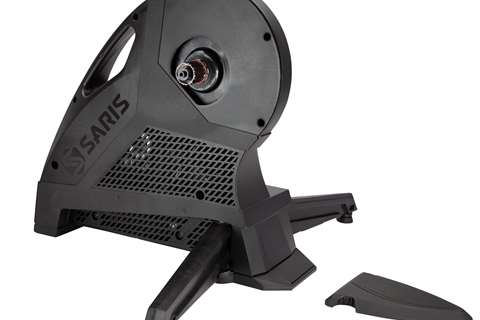
The H3 is a very good smart trainer, and superior in some ways to the Flux models, although the Flux 2 and Flux S are sold at a discount compared to the H3.
Let’s start the noise level, which gets lots of PR but for good reason — it is a factor for many people. The Flux models — either the 2 or the S — are going to be quieter than the H3. The H3’s noise is not really a roar or a rumble, but rather a bit of a whine. And it isn’t bad. The H3 is a big improvement from the H2, which had a consistent whine but was otherwise a durable unit.
The H3 has a heavier, larger flywheel, by quite a lot. In fact, it is the largest flywheel of any models we look at. This means that it gives you great, quality inertia, and responsiveness when ramping up or down. You are not going to outpower th H3’s flywheel. The Flux 2’s flywheel is smaller and lighter, but still legitimate. The Flux S’s flywheel is more of a step-down, so if you are a high-power cyclist or annoyed by lite latency in power, you might want to consider the H3.
The H3 can simulate a grade of up to 20%, while the Flux 2 can do 16%.
The H3 has the edge when it comes to foldability, if that is important for you when the unit is not in use.
Both trainers are very good options, and are actually two of our very favorite trainers for the money. Find the H3 here, and the Flux 2 here.
Tacx Flux vs. the Wahoo KICKR Core
Wahoo has a few models in its lineup, but the KICKR Core (here) is at a price point that literally goes head-to-head with the Tacx Flux 2, and is priced just a little above the Flux S. When it comes to a true head-to-head matchup, the Flux 2 vs. KICKR Core is a worthy competition. The Core is the less-expensive and less-appointed version of the Wahoo KICKR.
They are comparable in many respects. 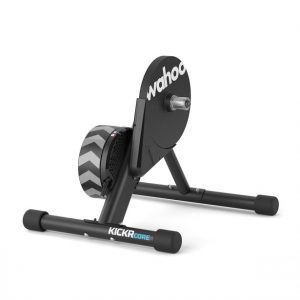
They both can get you up to relatively high power output levels, although the Flux 2 gives you a little more (2,000 watts) if you need it. The KICKR Core maxes out at 1,800 watts. In terms of incline simulation, both are identical at 16% grade max.
Given the footprint, weight, and overall design of the Flux 2, it is a little more stable than the KICKR Core on hard cranks, when you are out of the saddle and ripping up the frame. The Flux 2 is also rated for riders up to 275 lbs, whereas the KICKR Core is only rated up to 250 lbs. If you are a heavier rider, or someone who really cranks out of the saddle often, the Tacx might be the better choice.
The KICKR Core is about 10 lbs lighter than the Tacx Flux models, which might explain the lower overall stability when cranking hard.
Neither comes with a cassette, so you will need to purchase and install one after you get the unit.
Both are accurate to within about 2% (Wahoo) to 2.5% (Tacx) of actual power.
For the exact same money, we would give the edge to the Tacx Flux 2 because of the more stable ride and the higher potential power output (even if you don’t need the power, it is indicative of what the flywheel can handle.)
Tacx Neo 2T vs. Tacx Flux 2 vs. Tacx Flux S
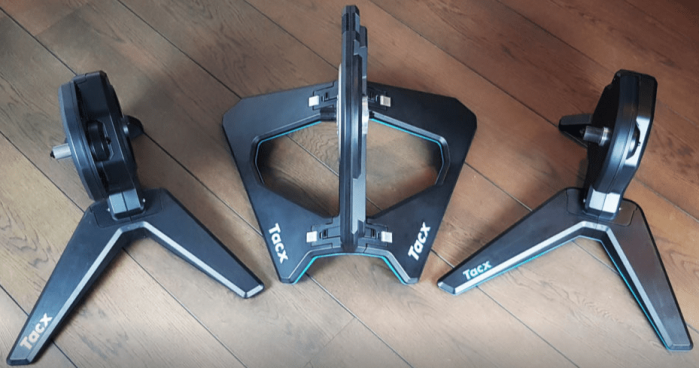
Perhaps the biggest question resides within Tacx’ own lineup. How do their three smart trainer models stack up against each other — the Neo 2T, Flux 2, and Flux S.
Let’s start first at the very top. The Neo 2T is a specimen of a machine, with lots of bells-and-whistles. The backlighting that tells you, in a color-coded way, what kind of power you a putting out. The ability to simulate various surfaces (like cobblestone or wooden bridges) on Zwift. Some side-to-side flex that makes your time in the saddle more comfortable.
Then, let’s go to the bottom. The Flux S is an entry-level smart trainer. While it will give you years of good riding, the lighter flywheel makes it a model where we think the extra $150 to get to a Flux 2 is worth it.
The Flux 2 is a good all-around bike trainer, capable of hard rides, quite stable, and able to get you some serious power as well as a 16% incline simulation. For the money, it is pretty darn impressive.
Let’s compare some specs:
Max Power: 2,200 on the Neo 2T, 2,000 on the Flux 2, and 1,500 on the Flux S
Weight limit: 275 pounds on all
Incline simulation: 30% on the Neo 2T, and 16% on the Flux 2, and 10% on the Flux S.
Accuracy: 1% on the Neo 2T, 2.5% for the Flux 2, 3% for the Flux S
Overall, three good models, but we think there is reason to focus on the Neo 2T or the Flux 2. The Flux 2 is probably the best value of the bunch.
Regardless of which model you buy, we suggest buying direct from Garmin who provides great customer services. For the best deals, buy direct here.
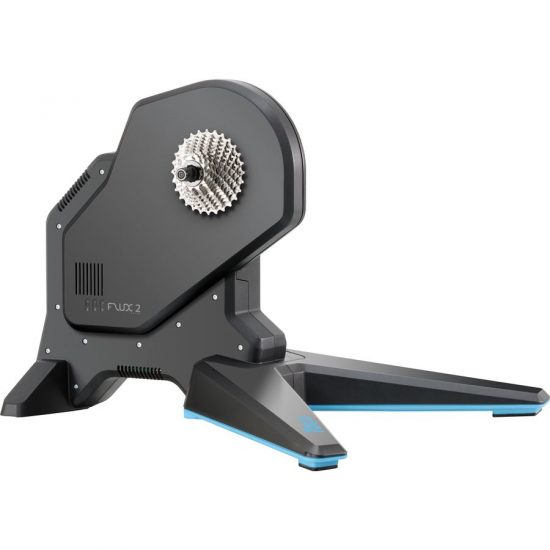








Are you aware of any bikes not being compatible with the tacx trainers. There seems to be some bikes identified for the kickr core that are not compatible or need special adapters.
Bikes with thru axles might requires special mods to make them compatible with the Tacx (and other) indoor trainers. That is the one example that comes to mind.
Your article was very helpful in assisting my quest for a new trainer. However, I did come across a personal example that makes the Flux 2 an even more compelling option. I have a Trek Domane carbon that has thru axles as apposed to quick releases. Consequently, the Flux S just became $70 more expensive and at current reduced/sale prices only $50 less than the Flux 2. It became a no brainer since the Flux 2 is 142×12 thru axle compatible out of the box. Thanks for a very informative review.
Excellent point, Terry. Thru-axles are a complicating factor and we probably should update the article. Many bike trainers aren’t quite sure how to handle them!